Post-Traumatic Growth – Transforming Pain
Traumatic Growth and Facing the Pain Instead of Avoiding It – Turning Pain into Strength: How to Use Scam Trauma for Emotional Growth
Primary Category: Scam Victim Recovery Psychology
Authors:
• Vianey Gonzalez B.Sc(Psych) – Licensed Psychologist, Specialty in Crime Victim Trauma Therapy, Neuropsychologist, Certified Deception Professional, Psychology Advisory Panel & Director of the Society of Citizens Against Relationship Scams Inc.
• Tim McGuinness, Ph.D., DFin, MCPO, MAnth – Anthropologist, Scientist, Polymath, Director of the Society of Citizens Against Relationship Scams Inc.
About This Article
Traumatic growth happens when you choose to engage with your pain instead of avoiding it. After a scam, you may feel broken, ashamed, or lost, but those feelings do not mean you have failed. They mean you have been deeply hurt. Healing begins when you face that hurt honestly. You allow yourself to grieve what was lost. You begin to rebuild emotional awareness and trust your feelings again. You create a story that includes your strength, not just your suffering. Over time, you may discover that your pain can fuel a sense of purpose. That purpose does not erase the trauma, but it gives it direction. You are not defined by what happened to you. You are defined by how you choose to respond. Every step you take toward healing, no matter how small, becomes part of your transformation. You do not need to go back to who you were. You can grow into someone stronger, wiser, and more fully alive.
Note: This article is intended for informational purposes and does not replace professional medical advice. If you are experiencing distress, please consult a qualified mental health professional.
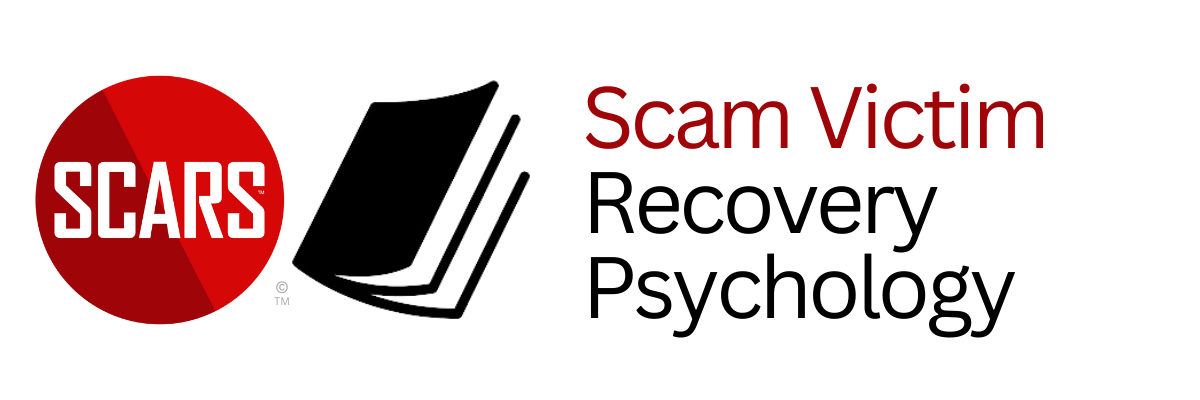
Traumatic Growth and Facing the Pain Instead of Avoiding It – Turning Pain into Strength: How to Use Scam Trauma for Emotional Growth
This article is about Traumatic Growth.
Defining Traumatic Growth
Traumatic growth, also known as post-traumatic growth, refers to the positive psychological and emotional changes that can emerge after a person experiences significant adversity or trauma. It is not the trauma itself that causes growth, but rather how you process and respond to it over time. This concept recognizes that while trauma often causes deep pain, confusion, and suffering, it can also serve as a catalyst for transformation—if you engage with it honestly, consciously, and with support.
Traumatic growth does not mean the trauma was good, justified, or worth it. The pain is still real, and the damage may still be lasting. However, through active reflection and emotional recovery, you may discover new perspectives, deeper strength, and a greater sense of purpose. You may rebuild your life with stronger boundaries, clearer values, and renewed trust in yourself.
Common areas of growth include a deeper appreciation for life, closer relationships, increased personal resilience, and a stronger sense of meaning. These changes are not automatic. They require effort, patience, and a willingness to confront uncomfortable truths. Traumatic growth is not about moving on—it is about moving through. It is not about forgetting what happened—it is about using your experience to create something stronger than what was lost.
Facing the Pain
When you experience the emotional collapse that comes with being scammed, you may feel as though your entire identity has been shattered. It is not just the money or the betrayal that breaks you. It is the way your trust, hope, and dignity were used against you. But your trauma is not a dead end. It is not a signal that your story is over. Instead, it can become the starting point of a new chapter. You do not need to avoid the pain to heal. You need to learn how to face it, understand it, and work with it. This is where traumatic growth begins.
After a scam, your first instinct might be to numb out, shut down, or distract yourself. That reaction makes sense. Your nervous system is overloaded. Your mind is trying to protect you. But avoiding your pain does not make it go away. It buries it, and what you bury finds other ways to surface—often through anxiety, depression, rage, or shame.
Traumatic growth begins when you choose to face what you feel. You do not need to solve everything at once. You only need to sit with your pain and acknowledge that it is there. You might say to yourself, “This hurts. I am afraid. I am ashamed. But I am here, and I will stay with this.” Naming your feelings without judgment is a powerful first step. It tells your body and mind that you are safe enough to begin the healing process.
Pain holds information. It tells you what mattered to you. It shows you where your values were violated. If you let it, pain can become a teacher. It does not have to be the enemy. It can show you what you care about, what you need to repair, and what boundaries you want to build moving forward.
Understanding the Purpose of Suffering
When you ask yourself, “Why did this happen to me?” you are doing more than trying to piece together events. You are reaching for meaning. This is not a shallow or passing question. It rises from a deep part of your emotional core, the part that needs the pain to count for something. When your world breaks, it is natural to want the suffering to serve a purpose. That desire is not weakness. It is your first sign of strength returning. It is a sign that you want to move forward with something more than just survival.
You may feel pressure to move on quickly, to bury the pain or act like it never happened. But real healing does not come from silence or avoidance. You do not heal by pretending the trauma was small. You heal by facing it and asking what it taught you. That is where post-traumatic growth begins. It is not about turning suffering into a gift. It is about using your suffering as raw material for growth. It is not the event itself that shapes you. It is your response, your choices, and your willingness to search for deeper truths within the experience.
Your suffering becomes meaningful when it changes how you live. Maybe it makes you more honest about what matters. Maybe it helps you stop tolerating things that harm you. Maybe it forces you to see your own resilience in ways you never considered before. These changes do not erase the pain, but they help give it direction. When you begin to live more intentionally, the suffering starts to feel less like meaningless damage and more like a turning point.
You might find yourself becoming more emotionally aware. You might take better care of yourself. You might learn how to protect your time and energy instead of giving it away to people who do not value it. These are not signs of weakness. These are signs of transformation. You are using what hurt you as fuel to become wiser, more focused, and more grounded.
This does not mean that what happened to you was good. It does not mean you should be grateful for the pain. You can still feel angry, betrayed, or heartbroken. You can still wish it had never happened. But growth means that you choose not to stay stuck in that pain. You decide not to let the scam, or the person who hurt you, define the rest of your life. You shape yourself deliberately, not as a victim, but as someone who is building forward from what happened.
You are not here to erase what happened. You are here to understand it, to use it, and to turn it into something useful. You are here to take your pain and give it a shape that serves your life. When you do that, suffering has a purpose. And with that purpose, you begin to heal.
Allowing Yourself to Grieve
Grief is not optional after a scam. It is necessary. You may want to skip past it, stay busy, or pretend you are unaffected. But if you avoid it, the grief will stay with you. It will find other ways to surface. You may think grief only belongs in situations of death, but you are grieving something very real. You lost more than money. You lost trust, safety, and the future you believed in. You lost a version of yourself who thought the world made more sense than it does now.
You might have believed the person on the other end truly cared about you. You might have planned your future with them. You might have seen yourself finally feeling secure, happy, or loved. That vision was real to you, even if it turned out to be based on lies. When the scam ended, that vision collapsed. You have the right to grieve that loss. You do not need anyone’s permission to feel heartbroken, angry, or betrayed.
Allow yourself to grieve without apology. Cry if you need to. Write about what you thought your life was becoming. Speak out loud about what hurts, even if you are alone. Grief needs expression. If you keep it bottled up, it does not disappear. It turns inward and starts to color everything you do. It may lead you to mistrust people who deserve trust. It may keep you stuck in fear when you want to move forward. Facing grief directly helps you prevent that.
Make space in your life to feel what you feel. Sit quietly and let the emotions rise. If you feel rage, let yourself name it. If you feel sadness, let the tears come. If you feel ashamed, speak that shame aloud so it loses its power. These emotions are not problems to fix. They are signals from your nervous system that something valuable was lost. When you respond to them with honesty and care, you begin to heal.
You may feel tempted to rush this process. You may hear people tell you to get over it or move on. But healing does not follow a timeline. If you push yourself to act fine when you are not, you will carry that grief with you into the future. It will affect how you relate to others, how you make decisions, and how you see yourself. Give yourself the time and attention this pain deserves.
You will not feel this way forever. Grief, when processed, changes. It becomes something you carry with more ease. It may even lead to insight or strength you did not know you had. But that only happens if you face it. When you allow yourself to grieve fully, you honor the truth of your experience. You stop pretending. You stop hiding from your own heart. That honesty opens the door to real recovery.
Let yourself be honest. Let yourself feel. Let yourself grieve. This is how you begin again.
Building Emotional Awareness
After a scam, you will find yourself emotionally disoriented. You question your instincts, doubt your reactions, and feel unsure of what emotions to trust. Scam trauma can disrupt your connection to your inner world. You might not even realize how shut down you have become until someone asks how you feel, and you cannot answer. This disconnection is common. When someone manipulates you and betrays your trust, your emotional system goes into a kind of lockdown. It tries to protect you by numbing or blurring signals that once guided your decisions. Unfortunately, that same protection also keeps you from healing.
To rebuild that connection, you need to create small, steady moments of emotional check-in. These are not dramatic confrontations with your past. They are quiet, curious observations of what is happening inside you. You can start by asking yourself simple questions throughout the day: “What am I feeling right now?” “Where in my body do I feel it?” “What do I need in this moment?” These questions bring your attention back to yourself. They show you that you still have access to your emotions, even if they feel unfamiliar or distant.
You do not need to have perfect answers. It is enough to notice that you feel tightness in your chest or heaviness in your stomach. It is enough to realize you feel anxious or sad without knowing exactly why. The goal is not to analyze your emotions but to recognize them. Each time you name what you feel, you reduce its power to overwhelm you. You also create space between the emotion and your next action, which gives you more control and clarity.
You might worry that emotional awareness will make you feel worse. You might think that naming your fear or grief will only increase it. But the opposite is usually true. When you acknowledge a feeling, you stop fighting it. That acceptance lowers your internal tension. It tells your nervous system that you are paying attention, which helps calm the stress response. You are not trying to shut down your emotions or get rid of them. You are learning to stay with them long enough to understand what they are trying to show you.
This awareness also helps you make better decisions. You may begin to notice when fear makes you want to isolate, or when shame tempts you to lie about what happened. You begin to recognize patterns. You realize that anger often follows hurt, or that sadness sometimes hides beneath your irritation. These insights give you the ability to choose your response. Instead of reacting from habit or confusion, you respond from awareness and care. That shift is what creates emotional growth.
You cannot heal what you do not notice. Building emotional awareness brings your feelings out of the shadows. It helps you become more honest, more grounded, and more present. You regain access to parts of yourself that trauma once silenced. That connection will not happen all at once, but it will grow stronger with practice. Over time, you will trust your emotional signals again. You will know what you feel, what you need, and what boundaries to set. This self-knowledge becomes a powerful part of your recovery.
Creating a Narrative That Includes Your Strength
You are not just a scam victim. You are a person who experienced something destabilizing, confusing, and deeply painful. That experience shook your confidence and disrupted your sense of trust, but it did not erase your value. You are still here. That alone shows resilience. You may not feel strong yet, but the fact that you are reading this, thinking about healing, and trying to understand your experience means you have already begun.
When you go through something traumatic like a scam, your mind tends to fixate on the damage. You replay the loss. You focus on what you missed, what you ignored, and how you failed to stop it. That reaction is normal. But it does not have to be the whole story. You can write a fuller narrative—one that acknowledges what happened without reducing you to the worst thing you endured. You do not erase the pain, but you also include the parts that show your courage, your growth, and your decision to move forward.
Start by noticing the moments when you took action, even while in pain. Maybe you stopped sending money. Maybe you told someone the truth after weeks or months of silence. Maybe you got up in the morning, made your coffee, and tried to make sense of your life again. These may seem small, but they matter. They show movement. They show agency. They show that you are not frozen in the past. When you tell your story, make room for these turning points. Let them sit beside the hard parts.
Create a version of your story that you would share with someone who needs encouragement. Not a fairy tale or a fake success story, but a real and balanced account. Include the moments when you felt broken, but also the moments when you reached for help. Include your self-doubt, but also your decision to read one more article, speak to one more person, or attend one more support group. This is not about pretending to be strong. It is about recognizing that your strength was already there, even when you were hurting.
You can use journaling, voice notes, or private writing to begin shaping this narrative. Use your own words. You might say something like: “I survived something I did not think I could survive. I am learning who I am when everything is stripped away. I am not who I was, but I am still mine.” These words give your pain context. They show that while the scam took something from you, it did not take everything. You still have your voice. You still have your power to define what this experience means.
When you create a narrative that includes your strength, you start to rebuild your identity on your own terms. You stop seeing yourself as just a victim. You begin to see yourself as someone who endured a storm and is now deciding what kind of life to build in its aftermath. That is not denial. That is ownership. And ownership is one of the clearest signs of post-traumatic growth.
Channeling Pain into Purpose
When you begin to feel like your pain no longer has the final word, you can start to use it in ways that serve you and others. Pain does not need to sit silently in the background of your life, controlling how you think and act. You can engage with it, learn from it, and redirect its energy. One of the most powerful steps you can take in recovery is to transform your suffering into something purposeful. This does not mean you are grateful for the pain, and it does not mean you have to like what happened. It means you choose not to waste the lessons it gave you.
Purpose begins with small acts. You might start by sharing your story with someone who feels alone. You might join a support group or answer a question in an online forum. These small choices carry weight. They connect you to others and break the isolation that trauma often creates. Your experience, once a source of shame or confusion, becomes a tool for clarity. It allows you to speak to others in a way that only someone who has been through it can. When you use your voice, your pain becomes part of something constructive.
You might also support someone privately who is going through a hard time. You recognize the look in their eyes, the silence in their voice, or the way they second-guess themselves. You know what it feels like to lose trust in the world. That understanding becomes your gift. You do not need to fix anyone. Just being present, listening without judgment, or gently encouraging someone can make a lasting difference. In these moments, your pain finds direction—it gives you insight, empathy, and a sense of shared strength.
Purpose does not have to be public. You do not have to become an advocate or create a large platform. Maybe your purpose is deeply personal. Maybe it is to live with more honesty. Maybe it is to create stronger boundaries in your relationships. Maybe it is to teach your children how to recognize emotional manipulation so they do not repeat your experience. These quiet shifts matter. They shape the future in ways that are real, even if no one else sees them.
What matters most is that your purpose is sincere. It must come from your values and reflect what feels meaningful to you. When you give your pain a job to do, you stop feeling powerless. You are no longer just someone who was hurt. You are someone who chose to build something from that hurt. That act of creation marks a turning point. It changes how you view yourself, and it restores a sense of agency that trauma tried to take away.
Purpose gives direction to your pain. It turns the wound into a seed. And when that seed grows, you begin to realize that you are not just recovering. You are becoming. You are shaping a future that includes your past but is not controlled by it. That is how pain becomes something more. That is how you move forward with purpose.
Conclusion
The Decision to Grow From Pain
You did not ask to be hurt. You did not plan for betrayal or prepare for the collapse that followed the scam. But you now face a decision that will shape your future. You can carry the pain as a burden that weighs you down, or you can begin to shape it into something useful. That choice belongs to you.
You cannot erase what happened. The scam disrupted your trust, your finances, and your sense of safety. It left you with grief, shame, and confusion. Those are not signs of weakness. They are normal responses to deep emotional harm. But if you stay in those feelings without movement, the trauma continues to define you. When you begin to engage with your pain rather than avoid it, you start to reclaim your power.
Growth does not happen all at once. It starts with small decisions. You decide to feel instead of going numb. You decide to reflect instead of react. You decide to speak the truth about what happened, even if your voice shakes. These steps feel small in the moment, but they mark the beginning of your transformation. You show yourself that you are not broken. You are still capable of healing, learning, and building something new.
You must allow yourself to grieve honestly. You lost more than money. You lost a vision of the future. You lost a sense of trust in others and possibly in yourself. That grief deserves space and attention. Do not rush to appear okay. When you process grief, you clear space for clarity. That clarity will help you recognize what matters now.
You must also learn to feel your emotions before they control your behavior. Scam trauma often blunts your emotional signals. You may not know when you feel fear, sadness, or anger until those feelings explode. By checking in with yourself each day, you begin to rebuild your emotional awareness. That awareness protects you. It helps you set boundaries, choose safe people, and make steady decisions. It connects you with the parts of yourself that trauma tried to silence.
You do not need to pretend that this experience made you stronger. You do not need to celebrate the pain or thank the scammer. But you can still decide that the pain will not go to waste. You can create a new narrative that includes your strength. You can say to yourself, “I faced something I never expected. I did not give up. I am choosing to keep going.” That story belongs to you, and it does not need to impress anyone. It only needs to reflect the truth of your survival and your recovery.
As you keep healing, you may discover a deeper purpose. You may find meaning in helping others, protecting your family, or living with more honesty and care. That purpose does not erase the pain, but it gives it direction. When you give your suffering a purpose, you turn it into something that serves your life instead of limiting it. That is the heart of traumatic growth.
You will not feel healed every day. You will still face setbacks, triggers, and moments of doubt. But as long as you keep choosing to move forward, you continue to change. You continue to grow. You do not need to return to who you were before. You can become someone wiser, more grounded, and more fully aware of your own worth.
This is not about forgetting. This is about becoming. You carry your story with you, but you choose how to carry it. You shape it into something that holds your truth, your strength, and your future. That is what healing looks like when you face the pain instead of running from it. That is what it means to grow through trauma.
Please Rate This Article
Please Leave Us Your Comment Below
Also, tell us of any topics we might have missed.
-/ 30 /-
What do you think about this?
Please share your thoughts in a comment above!
ARTICLE RATING
TABLE OF CONTENTS
- Traumatic Growth and Facing the Pain Instead of Avoiding It – Turning Pain into Strength: How to Use Scam Trauma for Emotional Growth
- About This Article
- Traumatic Growth and Facing the Pain Instead of Avoiding It – Turning Pain into Strength: How to Use Scam Trauma for Emotional Growth
- Defining Traumatic Growth
- Facing the Pain
- Understanding the Purpose of Suffering
- Allowing Yourself to Grieve
- Building Emotional Awareness
- Creating a Narrative That Includes Your Strength
- Channeling Pain into Purpose
- Conclusion
CATEGORIES
U.S. & Canada Suicide Lifeline 988
![NavyLogo@4x-81[1] Post-Traumatic Growth - Transforming Pain - 2025](https://scamsnow.com/wp-content/uploads/2025/04/NavyLogo@4x-811.png)
ARTICLE META
Important Information for New Scam Victims
- Please visit www.ScamVictimsSupport.org – a SCARS Website for New Scam Victims & Sextortion Victims.
- SCARS Institute now offers its free, safe, and private Scam Survivor’s Support Community at www.SCARScommunity.org – this is not on a social media platform, it is our own safe & secure platform created by the SCARS Institute especially for scam victims & survivors.
- SCARS Institute now offers a free recovery learning program at www.SCARSeducation.org.
- Please visit www.ScamPsychology.org – to more fully understand the psychological concepts involved in scams and scam victim recovery.
If you are looking for local trauma counselors, please visit counseling.AgainstScams.org
If you need to speak with someone now, you can dial 988 or find phone numbers for crisis hotlines all around the world here: www.opencounseling.com/suicide-hotlines
Statement About Victim Blaming
Some of our articles discuss various aspects of victims. This is both about better understanding victims (the science of victimology) and their behaviors and psychology. This helps us to educate victims/survivors about why these crimes happened and not to blame themselves, better develop recovery programs, and help victims avoid scams in the future. At times, this may sound like blaming the victim, but it does not blame scam victims; we are simply explaining the hows and whys of the experience victims have.
These articles, about the Psychology of Scams or Victim Psychology – meaning that all humans have psychological or cognitive characteristics in common that can either be exploited or work against us – help us all to understand the unique challenges victims face before, during, and after scams, fraud, or cybercrimes. These sometimes talk about some of the vulnerabilities the scammers exploit. Victims rarely have control of them or are even aware of them, until something like a scam happens, and then they can learn how their mind works and how to overcome these mechanisms.
Articles like these help victims and others understand these processes and how to help prevent them from being exploited again or to help them recover more easily by understanding their post-scam behaviors. Learn more about the Psychology of Scams at www.ScamPsychology.org
SCARS INSTITUTE RESOURCES:
If You Have Been Victimized By A Scam Or Cybercrime
♦ If you are a victim of scams, go to www.ScamVictimsSupport.org for real knowledge and help
♦ SCARS Institute now offers its free, safe, and private Scam Survivor’s Support Community at www.SCARScommunity.org – this is not on a social media platform, it is our own safe & secure platform created by the SCARS Institute especially for scam victims & survivors.
♦ Enroll in SCARS Scam Survivor’s School now at www.SCARSeducation.org
♦ To report criminals, visit https://reporting.AgainstScams.org – we will NEVER give your data to money recovery companies like some do!
♦ Follow us and find our podcasts, webinars, and helpful videos on YouTube: https://www.youtube.com/@RomancescamsNowcom
♦ Learn about the Psychology of Scams at www.ScamPsychology.org
♦ Dig deeper into the reality of scams, fraud, and cybercrime at www.ScamsNOW.com and www.RomanceScamsNOW.com
♦ Scam Survivor’s Stories: www.ScamSurvivorStories.org
♦ For Scam Victim Advocates visit www.ScamVictimsAdvocates.org
♦ See more scammer photos on www.ScammerPhotos.com
You can also find the SCARS Institute’s knowledge and information on Facebook, Instagram, X, LinkedIn, and TruthSocial
Psychology Disclaimer:
All articles about psychology and the human brain on this website are for information & education only
The information provided in this and other SCARS articles are intended for educational and self-help purposes only and should not be construed as a substitute for professional therapy or counseling.
Note about Mindfulness: Mindfulness practices have the potential to create psychological distress for some individuals. Please consult a mental health professional or experienced meditation instructor for guidance should you encounter difficulties.
While any self-help techniques outlined herein may be beneficial for scam victims seeking to recover from their experience and move towards recovery, it is important to consult with a qualified mental health professional before initiating any course of action. Each individual’s experience and needs are unique, and what works for one person may not be suitable for another.
Additionally, any approach may not be appropriate for individuals with certain pre-existing mental health conditions or trauma histories. It is advisable to seek guidance from a licensed therapist or counselor who can provide personalized support, guidance, and treatment tailored to your specific needs.
If you are experiencing significant distress or emotional difficulties related to a scam or other traumatic event, please consult your doctor or mental health provider for appropriate care and support.
Also read our SCARS Institute Statement about Professional Care for Scam Victims – click here
If you are in crisis, feeling desperate, or in despair, please call 988 or your local crisis hotline.
More ScamsNOW.com Articles
A Question of Trust
At the SCARS Institute, we invite you to do your own research on the topics we speak about and publish. Our team investigates the subject being discussed, especially when it comes to understanding the scam victims-survivors’ experience. You can do Google searches, but in many cases, you will have to wade through scientific papers and studies. However, remember that biases and perspectives matter and influence the outcome. Regardless, we encourage you to explore these topics as thoroughly as you can for your own awareness.


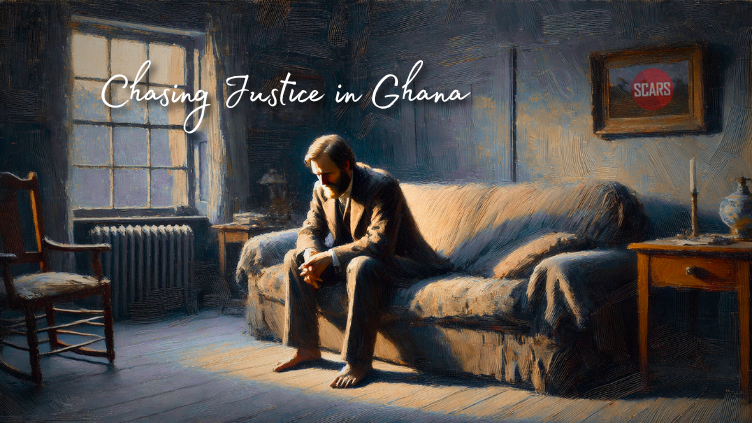

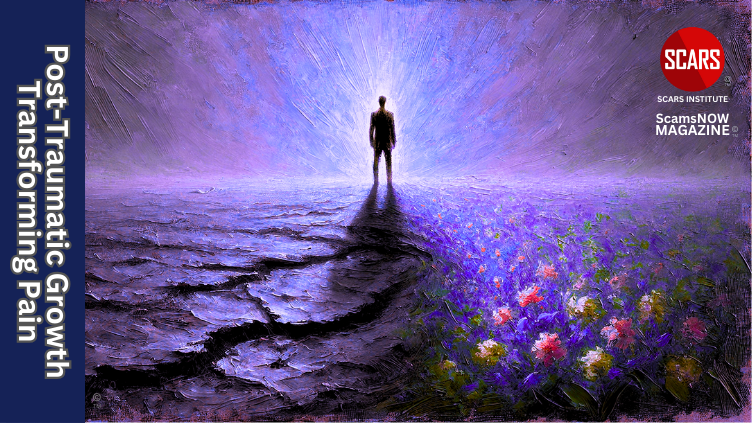
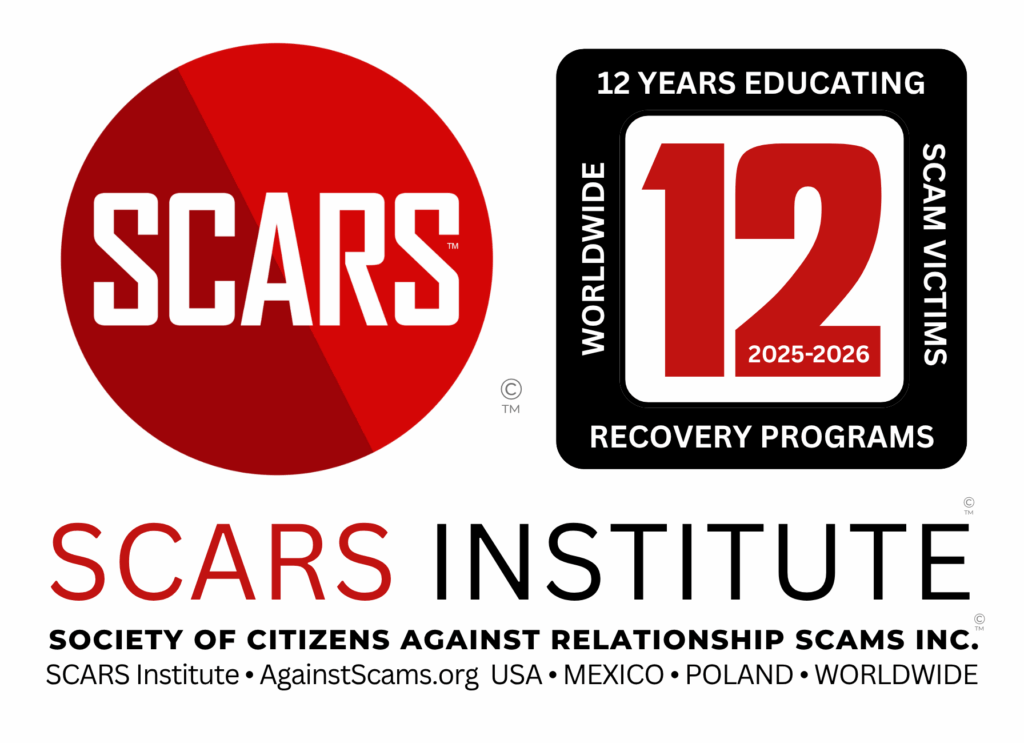










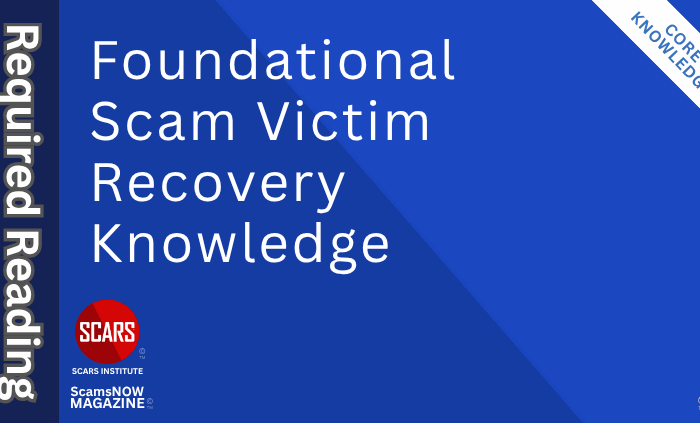







![scars-institute[1] Post-Traumatic Growth - Transforming Pain - 2025](https://scamsnow.com/wp-content/uploads/2025/04/scars-institute1.png)
![niprc1.png1_-150×1501-1[1] Post-Traumatic Growth - Transforming Pain - 2025](https://scamsnow.com/wp-content/uploads/2025/04/niprc1.png1_-150x1501-11.webp)
